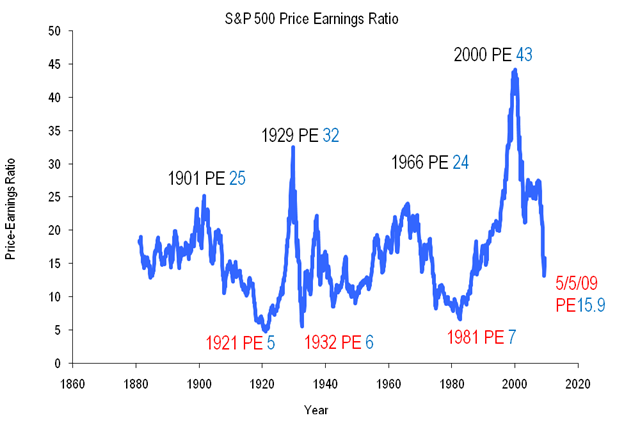
S&P500 PE History
In sales, there is a technique to make buyers decide to purchase called the “Ben Franklin Close”. It is a simple two column list with all the reasons to buy on one side and all the reasons not to on the other. The side with the greatest number of reasons shows which decision to make.
A broad stroke look like this of where the market is likely to go is useful if you are a mutual fund investor whose investments generally follow the whole market, or someone who’s willing to invest in inverse funds to benefit from downside moves. My list on whether to buy or sell the current market is shown below:
|
Reasons S&P500 will Go UP (BUY) |
Reasons S&P500 will Go DOWN (SELL) |
|
1. The market is still down 42% from its highs |
1. The market is up 25% from its lows. |
|
2. There is a lot of cash on the sidelines |
2. Market volume is moderate, at best. |
|
3. There are signs of improvement in the economy |
3. The economy decline was worse than anticipated in the first quarter, which could get even worse as initial reports are revised. |
|
4. The government has undertaken unprecedented monetary stimulus. |
4. Corporate earnings are forecast to decline until the 4th quarter (Standard & Poor’s) |
|
5. The government has some fiscal stimulus starting to kick in. |
5. Standard & Poor’s estimates that the S&P 500 will have a negative price/earnings (P/E) ratio in the third quarter of 2009 |
|
6. There has been some improvement in consumer confidence surveys and reported spending |
6. Dividends are declining (S&P500 first-quarter 2009 dividends $5.96, down from $7.15 in fourth quarter 2008) |
|
|
7. P/E ratios never hit the historic bottom. Currently S&P500 is about 15. The high historic bottom is 8 and the recent market bottomed at 12. (Based on 10 year averages as calculated by Robert Shiller) |
|
|
8. Housing prices continue to decline and could reach the levels of 2002 if the Japan experience is duplicated. |
|
|
9. The initial stress test shows that banks are still undercapitalized so lending will continue to be weak. |
If you have more reasons the market will go up, please add them in the comments. There are more reasons to put onto the down side but the list is already too depressing.
If you’re cautious, then the best thing is to be out of the market. If you’re aggressive than there seems to be more downside from here than there is upside and inverse funds are an opportunity for you.
If you’re a stock picker there are plenty of value stocks to pick from today though I’m personally waiting for the next leg down to buy.
Modern bankruptcy laws were implemented in 1898 after literally hundreds of years of experience proved that debtor’s prisons were ineffective. After all, if someone has no money putting them in prison simply eliminated the opportunity for them to make money to repay their debts. Since then, businesses have been trying to eliminate the opportunity for individuals to get out of debt, though they have never come up with a solution to most debtor’s major problem: lack of money.
The 2005 revision to the bankruptcy law tried to make sure people would try to repay debt. One section of it eliminated the opportunity for bankruptcy courts to modify “mortgages on primary residences by placing the portion above the market value of the house on par with other unsecured debts.” The logic in 2005 was that the financial companies that owned the mortgages would be better at judging whether to modify them than a bankruptcy judge. In 2009, we have some reason to doubt the judgment of finance companies.
In any case, I’ve never understood how banks could justify removing bankruptcy protection for primary residences while leaving it for second homes and investment properties. … When enacted, this clearly encouraged individuals to undertake moral hazard by gambling with the bank’s money on vacation homes and investment properties. It actually did this in practice (along with a lot of other distorting factors) as 1/3 of homes sold in 2005 were second or vacation homes. These vacation and second homes represent the majority of excess housing in the United States.

